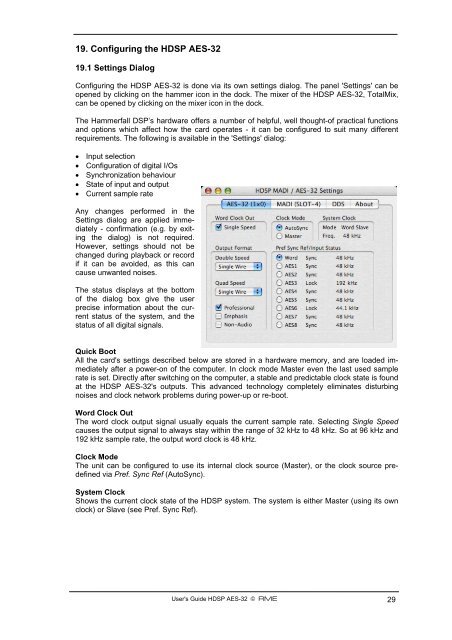Create successful ePaper yourself
Turn your PDF publications into a flip-book with our unique Google optimized e-Paper software.
19. Configuring the <strong>HDSP</strong> <strong>AES</strong>-<strong>32</strong><br />
19.1 Settings Dialog<br />
Configuring the <strong>HDSP</strong> <strong>AES</strong>-<strong>32</strong> is done via its own settings dialog. The panel 'Settings' can be<br />
opened by clicking on the hammer icon in the dock. The mixer of the <strong>HDSP</strong> <strong>AES</strong>-<strong>32</strong>, TotalMix,<br />
can be opened by clicking on the mixer icon in the dock.<br />
The Hammerfall DSP’s hardware offers a number of helpful, well thought-of practical functions<br />
and options which affect how the card operates - it can be configured to suit many different<br />
requirements. The following is available in the 'Settings' dialog:<br />
• Input selection<br />
• Configuration of digital I/Os<br />
• Synchronization behaviour<br />
• State of input and output<br />
• Current sample rate<br />
Any changes performed in the<br />
Settings dialog are applied immediately<br />
- confirmation (e.g. by exiting<br />
the dialog) is not required.<br />
However, settings should not be<br />
changed during playback or record<br />
if it can be avoided, as this can<br />
cause unwanted noises.<br />
The status displays at the bottom<br />
of the dialog box give the user<br />
precise information about the current<br />
status of the system, and the<br />
status of all digital signals.<br />
Quick Boot<br />
All the card's settings described below are stored in a hardware memory, and are loaded immediately<br />
after a power-on of the computer. In clock mode Master even the last used sample<br />
rate is set. Directly after switching on the computer, a stable and predictable clock state is found<br />
at the <strong>HDSP</strong> <strong>AES</strong>-<strong>32</strong>'s outputs. This advanced technology completely eliminates disturbing<br />
noises and clock network problems during power-up or re-boot.<br />
Word Clock Out<br />
The word clock output signal usually equals the current sample rate. Selecting Single Speed<br />
causes the output signal to always stay within the range of <strong>32</strong> kHz to 48 kHz. So at 96 kHz and<br />
192 kHz sample rate, the output word clock is 48 kHz.<br />
Clock Mode<br />
The unit can be configured to use its internal clock source (Master), or the clock source predefined<br />
via Pref. Sync Ref (AutoSync).<br />
System Clock<br />
Shows the current clock state of the <strong>HDSP</strong> system. The system is either Master (using its own<br />
clock) or Slave (see Pref. Sync Ref).<br />
<strong>User's</strong> <strong>Guide</strong> <strong>HDSP</strong> <strong>AES</strong>-<strong>32</strong> © <strong>RME</strong> 29
















